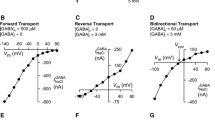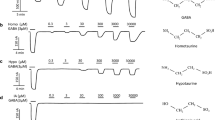Abstract
Three fenamates—niflumic, flufenamic and mefenamic acids—were tested for effects on substrate-induced currents of glutamate and glycine transporters (EAAT1, EAAT2, GLYT1b and GLYT2a) expressed in Xenopus laevis oocytes. All fenamates inhibited EAAT1 currents; 100 μM flufenamic acid produced the most inhibition, decreasing the I max by 53 ± 4% (P < 0.001). EAAT2 currents were less sensitive, but 100 μM flufenamic acid inhibited the I max by 34 ± 5% (P = 0.006). All fenamates inhibited GLYT1b currents; 100 μM flufenamic acid produced the most inhibition, decreasing the I max by 61 ± 1% (P < 0.001). At 100 μM, effects on the GLYT2a I max were mixed: 13 ± 2% inhibition by flufenamic acid (P = 0.002), 30 ± 6% enhancement by niflumic acid (P = 0.002), and no effect by mefenamic acid. Minor effects on substrate affinity suggested non-competitive mechanisms. These data could contribute to the development of selective transport modulators.




Similar content being viewed by others
References
Lerma J, Martin del Rio R (1992) Chloride transport blockers prevent N-methyl-D-aspartate receptor-channel complex activation. Mol Pharmacol 41:217–222
Halliwell RF, Thomas P, Patten D, James CH, Martinez-Torres A, Miledi R, Smart TG (1999) Subunit-selective modulation of GABAA receptors by the non-steroidal anti-inflammatory agent, mefenamic acid. Eur J Neurosci 11:2897–2905. doi:10.1046/j.1460-9568.1999.00709.x
Sinkkonen ST, Mansikkamaki S, Moykkynen T, Luddens H, Uusi-Oukari M, Korpi ER (2003) Receptor subtype-dependent positive and negative modulation of GABAA receptor function by niflumic acid, a nonsteroidal anti-inflammatory drug. Mol Pharmacol 64:753–763. doi:10.1124/mol.64.3.753
Woodward RM, Polenzani L, Miledi R (1994) Effects of fenamates and other nonsteroidal anti-inflammatory drugs on rat brain GABAA receptors expressed in Xenopus oocytes. J Pharmacol Exp Ther 268:806–817
Gogelein H, Dahlem D, Englert HC, Lang HJ (1990) Flufenamic acid, mefenamic acid and niflumic acid inhibit single nonselective cation channels in the rat exocrine pancreas. FEBS Lett 268:79–82. doi:10.1016/0014-5793(90)80977-Q
Hogg RC, Wang Q, Large WA (1994) Action of niflumic acid on evoked and spontaneous calcium-activated chloride and potassium currents in smooth muscle cells from rabbit portal vein. Br J Pharmacol 112:977–984
Lee YT, Wang Q (1999) Inhibition of hKv2.1, a major human neuronal voltage-gated K+ channel, by meclofenamic acid. Eur J Pharmacol 378:349–356. doi:10.1016/S0014-2999(99)00485-9
Liantonio A, Picollo A, Babini E, Carbonara G, Fracchiolla G, Loiodice F, Tortorella V, Pusch M, Camerino DC (2006) Activation and inhibition of kidney CLC-K chloride channels by fenamates. Mol Pharmacol 69:165–173
Malykhina AP, Shoeb F, Akbarali HI (2002) Fenamate-induced enhancement of heterologously expressed HERG currents in Xenopus oocytes. Eur J Pharmacol 452:269–277. doi:10.1016/S0014-2999(02)02330-0
Harks EG, de Roos AD, Peters PH, de Haan LH, Brouwer A, Ypey DL, van Zoelen EJ, Theuvenet AP (2001) Fenamates: a novel class of reversible gap junction blockers. J Pharmacol Exp Ther 298:1033–1041
Poulsen MV, Vandenberg RJ (2001) Niflumic acid modulates uncoupled substrate-gated conductances in the human glutamate transporter EAAT4. J Physiol 534:159–167. doi:10.1111/j.1469-7793.2001.00159.x
Fairman WA, Sonders MS, Murdoch GH, Amara SG (1998) Arachidonic acid elicits a substrate-gated proton current associated with the glutamate transporter EAAT4. Nat Neurosci 1:105–113. doi:10.1038/355
Zerangue N, Arriza JL, Amara SG, Kavanaugh MP (1995) Differential modulation of human glutamate transporter subtypes by arachidonic acid. J Biol Chem 270:6433–6435. doi:10.1074/jbc.270.12.6433
Bannwarth B, Netter P, Pourel J, Royer RJ, Gaucher A (1989) Clinical pharmacokinetics of nonsteroidal anti-inflammatory drugs in the cerebrospinal fluid. Biomed Pharmacother 43:121–126. doi:10.1016/0753-3322(89)90140-6
McGeer PL, McGeer EG (1996) Anti-inflammatory drugs in the fight against Alzheimer’s disease. Ann N Y Acad Sci 777:213–220. doi:10.1111/j.1749-6632.1996.tb34421.x
Gasparini L, Ongini E, Wenk G (2004) Non-steroidal anti-inflammatory drugs (NSAIDs) in Alzheimer’s disease: old and new mechanisms of action. J Neurochem 91:521–536. doi:10.1111/j.1471-4159.2004.02743.x
Szekely CA, Thorne JE, Zandi PP, Ek M, Messias E, Breitner JC, Goodman SN (2004) Nonsteroidal anti-inflammatory drugs for the prevention of Alzheimer’s disease: a systematic review. Neuroepidemiology 23:159–169. doi:10.1159/000078501
Joo Y, Kim HS, Woo RS, Park CH, Shin KY, Lee JP, Chang KA, Kim S, Suh YH (2006) Mefenamic acid shows neuroprotective effects and improves cognitive impairment in in vitro and in vivo Alzheimer’s disease models. Mol Pharmacol 69:76–84
Chen Q, Olney JW, Lukasiewicz PD, Almli T, Romano C (1998) Fenamates protect neurons against ischemic and excitotoxic injury in chick embryo retina. Neurosci Lett 242:163–166. doi:10.1016/S0304-3940(98)00081-0
Smolinske SC, Hall AH, Vandenberg SA, Spoerke DG, McBride PV (1990) Toxic effects of nonsteroidal anti-inflammatory drugs in overdose. An overview of recent evidence on clinical effects and dose-response relationships. Drug Saf 5:252–274. doi:10.2165/00002018-199005040-00003
Dodd PR, Scott HL, Westphalen RI (1994) Excitotoxic mechanisms in the pathogenesis of dementia. Neurochem Int 25:203–219. doi:10.1016/0197-0186(94)90064-7
Li S, Mallory M, Alford M, Tanaka S, Masliah E (1997) Glutamate transporter alterations in Alzheimer disease are possibly associated with abnormal APP expression. J Neuropathol Exp Neurol 56:901–911. doi:10.1097/00005072-199708000-00008
Scott HL, Pow DV, Tannenberg AE, Dodd PR (2002) Aberrant expression of the glutamate transporter excitatory amino acid transporter 1 (EAAT1) in Alzheimer’s disease. J Neurosci 22:RC206
Pearlman RJ, Aubrey KR, Vandenberg RJ (2003) Arachidonic acid and anandamide have opposite modulatory actions at the glycine transporter, GLYT1a. J Neurochem 84:592–601. doi:10.1046/j.1471-4159.2003.01549.x
White MM, Aylwin M (1990) Niflumic and flufenamic acids are potent reversible blockers of Ca2+-activated Cl− channels in Xenopus oocytes. Mol Pharmacol 37:720–724
Mitrovic AD, Amara SG, Johnston GA, Vandenberg RJ (1998) Identification of functional domains of the human glutamate transporters EAAT1 and EAAT2. J Biol Chem 273:14698–14706. doi:10.1074/jbc.273.24.14698
Aubrey KR, Mitrovic AD, Vandenberg RJ (2000) Molecular basis for proton regulation of glycine transport by glycine transporter subtype 1b. Mol Pharmacol 58:129–135
Gallagher MJ, Burgess LH, Brunden KR (1999) Characterization of multiple forms of the human glycine transporter type-2. Brain Res Mol Brain Res 70:101–115. doi:10.1016/S0169-328X(99)00135-7
Ju P, Aubrey KR, Vandenberg RJ (2004) Zn2+ inhibits glycine transport by glycine transporter subtype 1b. J Biol Chem 279:22983–22991. doi:10.1074/jbc.M312484200
Vandenberg RJ, Mitrovic AD, Chebib M, Balcar VJ, Johnston GA (1997) Contrasting modes of action of methylglutamate derivatives on the excitatory amino acid transporters, EAAT1 and EAAT2. Mol Pharmacol 51:809–815
Vandenberg RJ, Mitrovic AD, Johnston GA (1998) Molecular basis for differential inhibition of glutamate transporter subtypes by zinc ions. Mol Pharmacol 54:189–196
Kalgutkar AS, Marnett AB, Crews BC, Remmel RP, Marnett LJ (2000) Ester and amide derivatives of the nonsteroidal antiinflammatory drug, indomethacin, as selective cyclooxygenase-2 inhibitors. J Med Chem 43:2860–2870. doi:10.1021/jm000004e
Vandenberg RJ, Ju P, Aubrey KR, Ryan RM, Mitrovic AD (2004) Allosteric modulation of neurotransmitter transporters at excitatory synapses. Eur J Pharm Sci 23:1–11. doi:10.1016/j.ejps.2004.05.006
Mitrovic AD, Plesko F, Vandenberg RJ (2001) Zn2+ inhibits the anion conductance of the glutamate transporter EAAT4. J Biol Chem 276:26071–26076. doi:10.1074/jbc.M011318200
Seal RP, Shigeri Y, Eliasof S, Leighton BH, Amara SG (2001) Sulfhydryl modification of V449C in the glutamate transporter EAAT1 abolishes substrate transport but not the substrate-gated anion conductance. Proc Natl Acad Sci USA 98:15324–15329. doi:10.1073/pnas.011400198
Bhattacharyya DK, Lecomte M, Rieke CJ, Garavito M, Smith WL (1996) Involvement of arginine 120, glutamate 524, tyrosine 355 in the binding of arachidonate and 2-phenylpropionic acid inhibitors to the cyclooxygenase active site of ovine prostaglandin endoperoxide H synthase-1. J Biol Chem 271:2179–2184. doi:10.1074/jbc.271.33.20175
Greig GM, Francis DA, Falgueyret JP, Ouellet M, Percival MD, Roy P, Bayly C, Mancini JA, O’Neill GP (1997) The interaction of arginine 106 of human prostaglandin G/H synthase-2 with inhibitors is not a universal component of inhibition mediated by nonsteroidal anti-inflammatory drugs. Mol Pharmacol 52:829–838
Mancini JA, Riendeau D, Falgueyret JP, Vickers PJ, O’Neill GP (1995) Arginine 120 of prostaglandin G/H synthase-1 is required for the inhibition by nonsteroidal anti-inflammatory drugs containing a carboxylic acid moiety. J Biol Chem 270:29372–29377. doi:10.1074/jbc.270.49.29372
Copeland RA, Williams JM, Giannaras J, Nurnberg S, Covington M, Pinto D, Pick S, Trzaskos JM (1994) Mechanism of selective inhibition of the inducible isoform of prostaglandin G/H synthase. Proc Natl Acad Sci USA 91:11202–11206. doi:10.1073/pnas.91.23.11202
Smith WL, DeWitt DL (1995) Biochemistry of prostaglandin endoperoxide H synthase-1 and synthase-2 and their differential susceptibility to nonsteroidal anti-inflammatory drugs. Semin Nephrol 15:179–194
Pouplana R, Perez C, Sanchez J, Lozano JJ, Puig-Parellada P (1999) The structural and electronical factors that contribute affinity for the time-dependent inhibition of PGHS-1 by indomethacin, diclofenac and fenamates. J Comput Aided Mol Des 13:297–313. doi:10.1023/A:1008094616324
Rome LH, Lands WE (1975) Structural requirements for time-dependent inhibition of prostaglandin biosynthesis by anti-inflammatory drugs. Proc Natl Acad Sci USA 72:4863–4865. doi:10.1073/pnas.72.12.4863
Cullen KM, Kocsi Z, Stone J (2005) Pericapillary haem-rich deposits: evidence for microhaemorrhages in aging human cerebral cortex. J Cereb Blood Flow Metab 25:1656–1667. doi:10.1038/sj.jcbfm.9600155
Drachman DB, Frank K, Dykes-Hoberg M, Teismann P, Almer G, Przedborski S, Rothstein JD (2002) Cyclooxygenase 2 inhibition protects motor neurons and prolongs survival in a transgenic mouse model of ALS. Ann Neurol 52:771–778. doi:10.1002/ana.10374
Acknowledgments
Professor Graham Johnston is gratefully acknowledged for giving Robert Vandenberg the opportunity to establish the transporter biology group in the Discipline of Pharmacology at the University of Sydney. Professor Johnston’s mentorship and guidance, as Associate Supervisor for Suzanne Habjan during her PhD candidature, are highly appreciated. We thank staff and students who contributed to maintenance of the Xenopus laevis colony and isolation of oocytes, and the Australian Government National Health and Medical Research Council and the University of Sydney for supporting this work.
Author information
Authors and Affiliations
Corresponding author
Rights and permissions
About this article
Cite this article
Habjan, S., Vandenberg, R.J. Modulation of Glutamate and Glycine Transporters by Niflumic, Flufenamic and Mefenamic Acids. Neurochem Res 34, 1738–1747 (2009). https://doi.org/10.1007/s11064-009-9983-y
Received:
Accepted:
Published:
Issue Date:
DOI: https://doi.org/10.1007/s11064-009-9983-y




